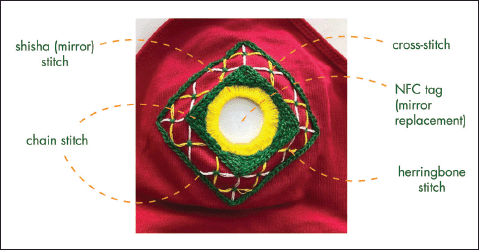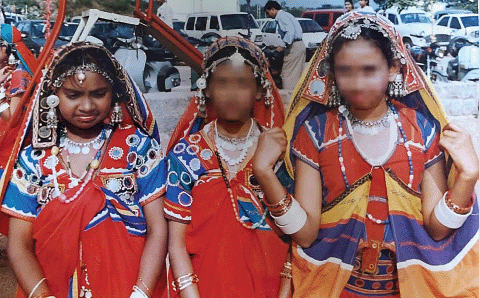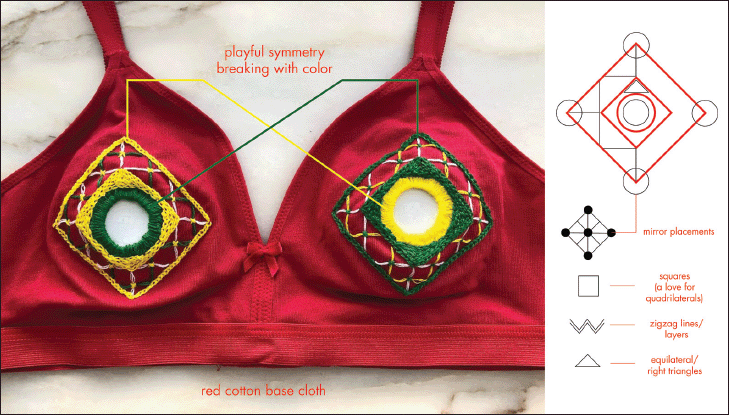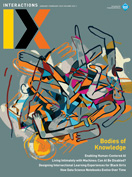Authors:
Anuradha Reddy
B00B-factor Authentication (pronounced bee-zero-zero-bee) is a project about making and breaking intimacy and trust. It combines traditional craft techniques with digital security methods such as two-factor authentication. Near-field communication (NFC) tags are incorporated into Banjara embroidery stitches, a heritage craft from my hometown, Hyderabad, Telangana, India. Taking the form of an interactive bra, B00B makes tactile an individual's experience of discomfort and insecurity when seeking intimacy and trust with people and communities they barely know.
 | Two NFC tags are stitched onto a bra, revealing encoded information when they come into close contact with a smartphone. The tag on the right nipple is programmed to open a password-protected webpage (the project documentation), whose content is accessed by unlocking the password via the left tag (see https://www.youtube.com/watch?v=41kjOXtUrxw&ab_channel=anuradhareddy). |
This project began with my curiosity about learning Banjara embroidery in connection with the craft community. The learning process has revealed sides of myself that I did not know existed, forcing me to confront my shifting identity and India as it exists today. By creating an electronic wearable that borrows craft techniques from home, I reflect from a distance on troubled intimacies while being between disparate cultures, communities, and technologies.
What is craft's role in establishing trust between communities? Can craft provide spaces for expressing one's discomfort and failure? How do we engage with technical literacy through craft?
To embed the NFC tags, I tried to imitate the traditional embroidery style common to the Banjara community. The embroidery, made mainly by women, is characterized by colorful stitch combinations and the embedding of small items like mirrors, coins, pom-poms, and cowrie shells into the fabric [1]. The Banjaras approach the order of stitches, thread colors, base fabric material, shapes, and patterns for each garment uniquely. This can be observed across their embroidery work, wherein no two pieces are identical. Improvising on the go, the crafter is invited to engage in creativity, aesthetics, and play. By utilizing primary and, at times, secondary colors, the Banjaras layer their stitches in ways that generate vibrant, unpredictable, and joyful designs [2].
 | Stitchwork (from center outward): shisha stitch, chain stitch, herringbone stitch, cross-stitch, chain stitch. |
Besides learning the craft, making B00B was an opportunity for me to learn about the history of the Banjara people and the ongoing impact that colonialism and casteism have on their communities to this day [3]. Having benefited from caste privilege throughout my life, I had to confront that I was trained in the same Indian design schools that assert dominance over indigenous craft communities by co-opting their culture for neoliberal motives. To further complicate matters, the Banjara craft identity has become a livelihood for many Banjara women who actively seek work and support their families [4]. Meanwhile, professionally trained designers like myself are preoccupied with narratives of "preserving" or "rescuing" the craft community from marketing forces and the threats of industrialization [5]. In navigating these contradictory forces and choke holds, I have come to understand the importance of approaching craft communities from interdisciplinary STEAM perspectives that embrace the potential of technical and vernacular creativity—connecting technical literacy, equity, and culture as a move toward creating generative justice [6].
1. Kwon, C. and McLaughlin, T. Textiles of the Banjara: Cloth and Culture of a Wandering Tribe. 2016; https://maiwa.com/products/textiles-of-the-banjara-hardcover
2. Tyabji, T., ed. Life passages in embroidery—the Lambani women artisans. In Threads & Voices: Behind the Indian Textile Tradition. Marg Foundation, 2007
3. Wadekar, L.D. Development challenges for denotified tribes in India: A talk on criminal justice system for denotified tribes. YouTube; https://youtu.be/emDqobYGcIA
4. Bhoomi, V. Banjara women work hand-in-hand to preserve traditional embroidery style in Telangana. New Indian Express. Aug. 15, 2021; https://www.newindianexpress.com/states/telangana/2021/aug/15/banjara-women-work-hand-in-hand-to-preserve-traditional-embroidery-style-in-telangana-2344843.html
5. DeNicola, A.O. and DeNicola, L. Cultural Studies 26, 6 (2012), 787–813, Rescue and Redemption: Design schools, traditional craft and the nation-state in contemporary India; https://www.tandfonline.com/doi/abs/10.1080/09502386.2012.668917
6. Eglash, R. An introduction to generative justice. Teknokultura 13 (2016), 369–404; https://www.researchgate.net/publication/311811471_An_Introduction_to_Generative_Justice
Anuradha Reddy is an interdisciplinary researcher living in Sweden. Her research combines interaction design with data technologies, creativity, and making/hacking. She is passionate about collaborative design processes that build capability in everyday users for tooling and grassroots innovation. Her recent creations tackle contemporary data technologies through craftivist and critical-making design practice. [email protected]
Copyright held by author
The Digital Library is published by the Association for Computing Machinery. Copyright © 2023 ACM, Inc.










Post Comment
No Comments Found